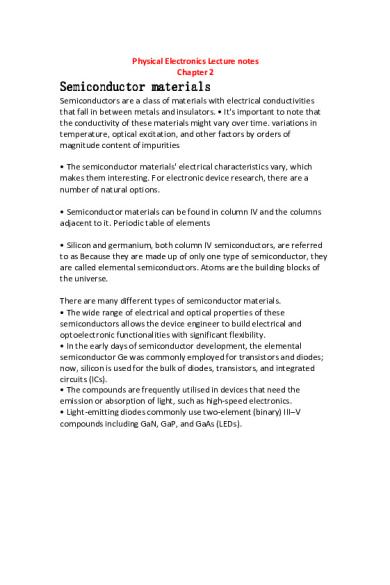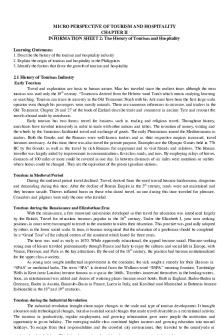Chapter 2 Physical Electronics Lecture notes PDF

| Title | Chapter 2 Physical Electronics Lecture notes |
|---|---|
| Author | Tae Kook |
| Course | Physical Electronics |
| Institution | University of Windsor |
| Pages | 6 |
| File Size | 430 KB |
| File Type | |
| Total Downloads | 50 |
| Total Views | 142 |
Summary
Chapter 2 Physical Electronics Lecture notes...
Description
Physical Electronics Lecture notes Chapter 2
Semiconductor materials Semiconductors are a class of materials with electrical conductivities that fall in between metals and insulators. • It's important to note that the conductivity of these materials might vary over time. variations in temperature, optical excitation, and other factors by orders of magnitude content of impurities • The semiconductor materials' electrical characteristics vary, which makes them interesting. For electronic device research, there are a number of natural options. • Semiconductor materials can be found in column IV and the columns adjacent to it. Periodic table of elements • Silicon and germanium, both column IV semiconductors, are referred to as Because they are made up of only one type of semiconductor, they are called elemental semiconductors. Atoms are the building blocks of the universe. There are many different types of semiconductor materials. • The wide range of electrical and optical properties of these semiconductors allows the device engineer to build electrical and optoelectronic functionalities with significant flexibility. • In the early days of semiconductor development, the elemental semiconductor Ge was commonly employed for transistors and diodes; now, silicon is used for the bulk of diodes, transistors, and integrated circuits (ICs). • The compounds are frequently utilised in devices that need the emission or absorption of light, such as high-speed electronics. • Light-emitting diodes commonly use two-element (binary) III–V compounds including GaN, GaP, and GaAs (LEDs).
Crystal Lattice • A crystalline solid is distinguished by the periodic arrangement of the atoms that make up the crystal. That is to say, there are some fundamentals. The atoms are arranged in a pattern that repeats throughout the solid. • At one point, the crystal looks exactly the same as it does at a sequence of others. Once the basic periodicity is known, further analogous points can be found. • It's important to understand that not all solids are crystals.
Some don't have any kind of periodic structure at all (amorphous solids), Some are made up of a lot of little single-crystal zones.
Periodic Structures To make a crystal, we can place atoms at each lattice point in an arrangement known as a basis, which can be one atom or a group of atoms with the same spatial arrangement. A two-dimensional arrangement of atoms known as a rhombic lattice with a primitive cell ODEF, which is the smallest such cell, is shown as an example of such a lattice. Notice that if the primitive cell is translated by integral multiples of these vectors, a new primitive cell identical to the original is found (e.g., O'D'E'F'). • The primitive vectors for the lattice are the vectors a and b (and c if the lattice is three-dimensional).
The diamond Lattice • The fcc lattice with a foundation of two atoms is the basic crystal structure for many major semiconductors, giving birth to the diamond structure, which is characteristic of Si, Ge, and C in diamond form. The following is one of the simplest ways to express the diamond structure's construction: An fcc lattice with an extra atom at a/4 + b/4 + c/4 from each of the fcc atoms can be thought of as the diamond structure. • Diamond lattice is a one-of-a-kind combination of two face-centeredcubic (fcc) unit cells. • An fcc obtains four more atoms from the penetrating fcc in a diamond lattice. • A silicon unit cell, for example, has a side length (lattice constant) of 5.4309 • In many compound semiconductors, atoms are arranged in a basic diamond structure, but are different on alternating sites. • This is called a zinc blende structure and is typical of the III–V compounds. • When the interpenetrating fcc is of a different material, the structure is a Zinc blende ( Ga→As GaAs) (a=5.65 Å)...
Similar Free PDFs

Lecture notes, Physical Geography
- 14 Pages

Lecture notes, lecture Chapter 2
- 11 Pages

Chapter 2 Lecture Notes
- 8 Pages

Chapter 2 Lecture Notes
- 24 Pages

Chapter 2 Lecture Notes
- 29 Pages

Chapter 2 - Lecture notes 2
- 30 Pages

Chapter 2 - Lecture notes 2
- 4 Pages

Chapter 2 - Lecture notes 2
- 11 Pages

Chapter 2 - Lecture notes 2
- 4 Pages

Chapter 2 - Lecture notes 2
- 3 Pages

Chapter 2 - Lecture notes 2
- 6 Pages
Popular Institutions
- Tinajero National High School - Annex
- Politeknik Caltex Riau
- Yokohama City University
- SGT University
- University of Al-Qadisiyah
- Divine Word College of Vigan
- Techniek College Rotterdam
- Universidade de Santiago
- Universiti Teknologi MARA Cawangan Johor Kampus Pasir Gudang
- Poltekkes Kemenkes Yogyakarta
- Baguio City National High School
- Colegio san marcos
- preparatoria uno
- Centro de Bachillerato Tecnológico Industrial y de Servicios No. 107
- Dalian Maritime University
- Quang Trung Secondary School
- Colegio Tecnológico en Informática
- Corporación Regional de Educación Superior
- Grupo CEDVA
- Dar Al Uloom University
- Centro de Estudios Preuniversitarios de la Universidad Nacional de Ingeniería
- 上智大学
- Aakash International School, Nuna Majara
- San Felipe Neri Catholic School
- Kang Chiao International School - New Taipei City
- Misamis Occidental National High School
- Institución Educativa Escuela Normal Juan Ladrilleros
- Kolehiyo ng Pantukan
- Batanes State College
- Instituto Continental
- Sekolah Menengah Kejuruan Kesehatan Kaltara (Tarakan)
- Colegio de La Inmaculada Concepcion - Cebu




